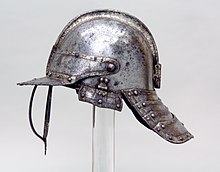Lobster-tailed pot helmet

Lobster-tailed pot helmet, also known as the zischägge, horseman's pot and harquebusier's pot, was a type of combat helmet. It was derived from an Ottoman Turkish helmet type. From c. 1600, it became popular in most of Europe and was especially worn by cavalrymen and officers. The helmet gradually fell out of use in most of Europe in the late 17th century; however, the Austrian heavy cavalry retained it for some campaigns as late as the 1780s.
Origin

The lobster-tailed pot helmet had an oriental origin, being derived from the
Characteristics

The lobster-tailed pot had a rounded skull-piece, which was sometimes fluted. The skulls of English-made helmets were usually formed from two sections, joined by a raised comb running from front to back; the skulls of helmets manufactured on the continent were most often raised from a single-piece of metal. Cheekpieces, commonly made in one piece but occasionally articulated, were attached to the skull by leather strapping; however, the better quality examples are sometimes hinged. To protect the face there was either a fixed forward projecting peak that incorporated a sliding nasal bar retained by a large screw, or a hinged peak with three attached bars. Finally, the helmet had a laminated defence (or a single-piece of plate ridged to imitate separate lames) to protect the back of the head and neck that was said to resemble the tail of a lobster.
Decoration and appearance

The appearance and finish of lobster-tailed pots varied greatly, from the highly decorated, superb-quality examples made for individual commanders down to crudely executed "munition-quality" types, which were mass-produced to equip large numbers of ordinary cavalry troopers. High quality helmets could be decorated using a range of techniques, including
Use

This form of helmet was widely used during the
Gallery
-
Cuirass and lobster-tailed pot helmet of the English Civil War (1642–1651), displayed at West Gate Towers and Museum, Canterbury, England.
-
Armour of Stephen Báthory (c. 1560, later King of Poland), displayed at the Kunsthistorisches Museum in Vienna, Austria.
-
Turkish conical helmets of 15th to early 16th century, displayed at Topkapı Palace, Istanbul, Turkey.
-
Turkish conical helmets and body armour of 15th to early 16th century, displayed at Topkapı Palace, Istanbul, Turkey.
-
Chichak (šišak, zischagge or erikhonka) ofbattle of Szigetvár- rear side
Notes
- ^ Robinson 2002, pp. 62–63
- ^ a b c Blackmore 1990, pp. 15–16
- ^ Oakeshott 1980, pp. 221–222
- ^ Tincey 1990, p. 5
- ^ Blackmore 1990, p. 15
- ^ Blackmore 1990, p. 16
- ^ Tincey 1990, p. 11
- ^ Bull 1991, pp. 111, 118, 121
- ^ Tincey 1990, pp. 11–12
- ^ Tincey 1990, p. 12
- ^ Brzezinski 1987, p. 7
- ^ Haythornthwaite 1994, p. 16
References
- Blackmore, D. (1990). Arms & Armour of the English Civil Wars. Trustees of the Royal Armouries. ISBN 0-948092-08-4.
- Brzezinski, R. (1987). Polish Armies 1569-1696. Men-at-Arms. Vol. 1. Osprey Publishing. ISBN 978-0-85045-736-0. MAA 184.
- Bull, S. (1991). An Historical Guide to Arms and Armour. Studio Editions. ISBN 1-85170-723-9.
- Haythornthwaite, P. (1994). The Austrian Army, 1740-1780: Cavalry. Osprey Publishing. ISBN 1-85532-415-6.
- Oakeshott, Ewart (1980). European Weapons and Armour: From the Renaissance to the Industrial Revolution. Lutterworth Press. OCLC 7284129.
- Robinson, H.R. (2002). Oriental Armour. Dover. ISBN 0-486-41818-9.
- Tincey, J. (1990). Soldiers of the English Civil War. Vol. 2 Cavalry. Osprey Publishing. ISBN 0-85045-940-0.





